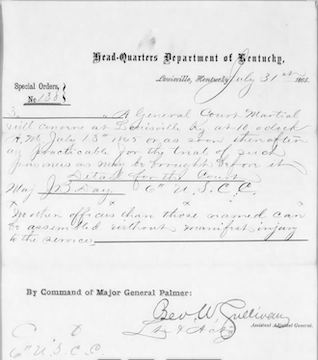USCT, USCI, USCC, etc.: What Do All Those Letters Mean?

Emerging Civil War is pleased to welcome back Tim Talbott
On May 22, 1863, the United States War Department issued General Order 143, creating the Bureau of Colored Troops. Article VI of the order states: “Colored troops may be accepted by companies, to be afterward consolidated in battalions and regiments by the Adjutant General. The regiments will be numbered seriatim, in the order in which they are raised, the numbers to be determined by the Adjutant General. They will be designated: ‘——Regiment of U. S. Colored Troops.’”
Like the White Federal state regiments raised to fight the war, African American regiments consisted of units serving in one of the three primary branches of service: infantry, cavalry, and artillery. While USCT (United States Colored Troops) became the universal abbreviated name for Black soldiers, USCI (United States Colored Infantry), USCC (United States Colored Cavalry), and USCA and USCHA (United States Colored Artillery and United States Colored Heavy Artillery) also found common use when recording information about the regiments. There were over 100 USCIs, six USCCs, and over a dozen Black artillery units established by the end of the Civil War. Therefore, it was a fairly common practice to call the regiments by their individualized abbreviations, particularly for cavalry and artillery. Period documents bear this out. However, it is also common to find an USCI regiment referred to in the universal USCT.
Some African American regiments started their existence with state designations. Examples include the 1st South Carolina Colored Infantry, 2nd North Carolina Colored Infantry, and the 1st Kansas Colored Infantry. While most state designated Black regiments eventually received United States Colored Troop numbers—for instance the 1st South Carolina became the 33rd USCI, the 2nd North Carolina became the 36th USCI, and the 1st Kansas became the 79th USCI—some retained state regimental designations. Examples of those units that kept their state names include the 54th and 55th Massachusetts Infantry, the 5th Massachusetts Colored Cavalry, and the 29th Connecticut Infantry.
To help provide clarification for readers, many modern historians incorporate the USCI, USCC, USCA, USCHA abbreviations when referring to specific USCT regiments. So, instead of writing 5th USCT, which could be any of the branches of service, using 5th USCI, 5th USCC, or 5th USCHA helps avoid confusion.



————
Sources:
Doback, William A. Freedom By the Sword: The U.S. Colored Troops, 1862-1867. Skyhorse Publishing, 2013.
War Department General Order 143: Creation of the U.S. Colored Troops. Located at: https://www.archives.gov/milestone-documents/war-department-general-order-143 accessed on July 5, 2022.
————
Tim Talbott is the Chief Administrative Officer for the Central Virginia Battlefields Trust. He is the former Director of Education, Interpretation, Visitor Services, and Collections at Pamplin Historical Park and the National Museum of the Civil War Soldier in Petersburg, Virginia. Tim is also the founding member and President of the Battle of New Market Heights Memorial and Education Association. He maintains the “Random Thoughts on History” blog and has published articles in both book and scholarly journal format. Tim’s current project is researching soldiers captured during the Petersburg Campaign.
thanks Tim … very informative post … the state designations — 54th MA, 29th CT, et al — brings to mind a question about the USCT regiments … given their designation as United States troops, have miltary historians ever considered them as “regulars” along with their white brothers in arms?
Thanks! I don’t remember any modern historian making a case for USCTs bring considered regular US during the war. Of course, after the war they are regulars.
And a few more (including Engineers) encountered during research: http://lestweforget.hamptonu.edu/page.cfm?uuid=9FEC4271-BC46-C816-EADBC549A88DAEAB
The abbreviations for the above are C.d’A. and A.D.
My great- great – great- great- grandfather was assigned to H Company 2nd Regiment USCC. Sgt Peter Boggs from Accomac County VA. He was wounded at the Battle of Petersburg and Virginia Where can I get more information about Peter Boggs. I know he was injured when the horse he was riding was shot from under him and injury Peter Boggs leg. I would be thankful if someone could help me find more info about Sgt Peter Boggs. Thank you